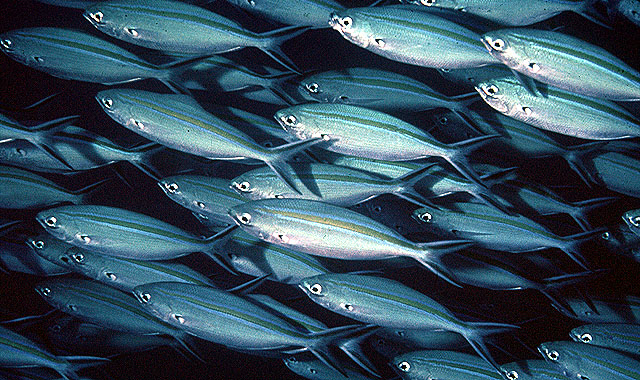| Caesionidae (Fusiliers), subfamily: Caesioninae |
| 45.4 cm FL (male/unsexed); max.weight: 1,634.0 g |
|
reef-associated; marine; depth range 1 - 60 m, non-migratory |
| Indo-West Pacific: Red Sea and East Africa to Samoa, north to southern Japan, south to New Caledonia. Absent in the Arabian (Persian) Gulf. |
|
Dorsal spines (total): 10-10; Dorsal soft rays (total): 14-16; Anal spines: 3-3; Anal soft rays: 10-12. This species is distinguished by the following characters: postmaxillary process single; A III,12 (rarely 13); lateral line scales 57-65 (usually around 61); scale rows on spinous part of dorsal fin horizontal; supratemporal bands of scales often interrupted at dorsal midline by a scaleless zone, always a V-shaped scaleless zone anteriorly at midline intruding between the supratemporal band of scales; body colour with upper body bluish and the lower white to pale bluish; a single yellow or golden stripe directly above lateral line except on caudal peduncle where it is about 1 scale above lateral line, the yellow stripe 2 or 3 scales wide, bordered directly above and below by a white or light blue stripe which is about 1 scale wide, caudal-fin lobes with a black median streak (Ref. 68703).
Description: Body moderately deep, fusiform, elongate, and moderately compressed. Ratio of eye diameter to head length usually around 3.4-4.2; D X,15 (rarely 14 or 16); pectoral fins with 20 to 22 (rarely 19); scale rows above lateral line to origin of dorsal fin 7-10 (most frequently 9); scale rows below lateral line to origin of anal fin usually 15-18; predorsal scales 20-26; dorsal and anal fins scaled; greatest body depth 2.2-3.1 in SL, head length 2.7-3.4 in SL (Ref. 68703, 90102). |
| Adults are found in schools in deep lagoons and along seaward reefs in coastal areas (Ref. 9710), mixing with other species of fusiliers (Ref. 48636). Juveniles are used as tuna bait fish. They are oviparous, with small pelagic eggs (Ref. 402). Maximum depth reported taken from Ref. 128797. |
|
Least Concern (LC); Date assessed: 04 February 2009 Ref. (130435)
|
| harmless |
Source and more info: www.fishbase.org. For personal, classroom, and other internal use only. Not for publication.

